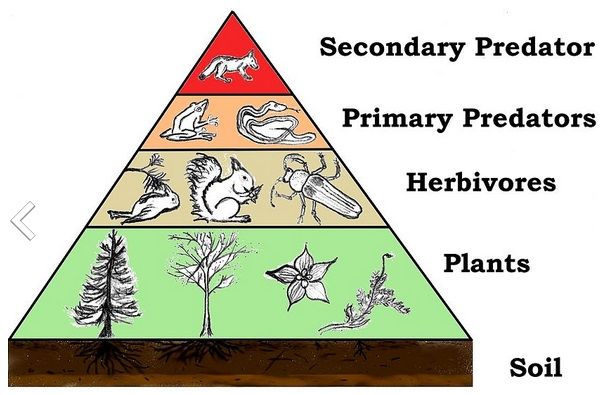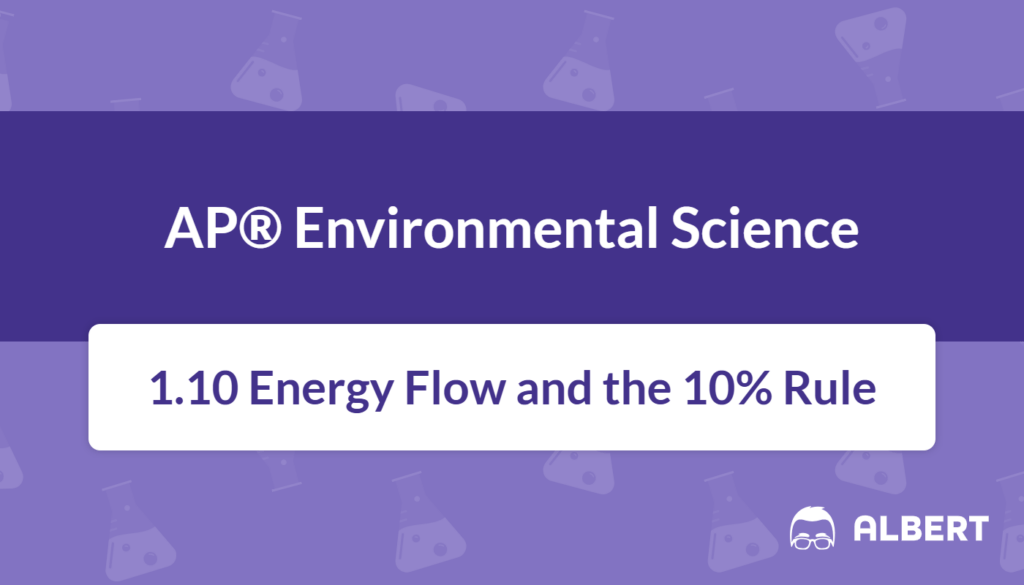What We Review
Energy Flow and the 10% Rule
Introduction
Energy drives every ecosystem on Earth. In AP® Environmental Science, understanding the path of energy flow through living systems is crucial. Ecosystems rely on energy to fuel all life processes, from plant growth to predator-prey interactions. However, energy transfer is not completely efficient. There are losses along the way, and only a small fraction of what is available at one level of the food chain is passed on to the next level.
Therefore, examining how energy flows and dissipates can reveal why certain ecosystems can support more organisms than others. It also shows why 10,000 kilojoules of energy at the base of a food chain might only result in 1,000 kilojoules for the next trophic level. These concepts connect with the laws of thermodynamics, highlighting that energy is continuously transformed and lost as heat.
What Is Energy Flow?
Energy flow refers to the direction and magnitude of energy transfer within an ecosystem. It normally starts with solar energy, which is captured by green plants and some other organisms. Next, through the process of photosynthesis, these organisms convert light energy into chemical energy stored in organic molecules.
In many ecosystems, sunlight is the primary energy source. However, other forms of energy exist as well. For instance, some deep-sea vent communities rely on chemical energy from sulfur compounds. Regardless of the energy origin, the flow is always one-way—once the energy leaves the ecosystem as heat, it cannot be reused by living organisms.
The Trophic Levels
Trophic levels describe the positions of organisms in a food chain, representing how energy moves from one group of organisms to another. These levels usually include:
- Producers (primary producers): Organisms that generate food from inorganic sources. They use photosynthesis or chemosynthesis. Green plants, algae, and some bacteria are typical producers.
- Primary consumers: These organisms feed directly on producers. They include herbivores like rabbits, deer, or certain insects.
- Secondary consumers: These organisms consume primary consumers. Carnivores such as small fish, frogs, or foxes often fit here.
- Tertiary consumers: These top-level predators eat secondary consumers. Examples include large fish, hawks, or apex predators like tigers.

Consider a simple aquatic ecosystem. Microscopic algae act as producers, transforming sunlight into biomass. Small aquatic herbivores, such as zooplankton, serve as primary consumers. Next, fish feeding on these zooplankton would be secondary consumers. Finally, larger fish or birds of prey that eat smaller fish become tertiary consumers. However, each stage passes on only a fraction of its energy to the next.
The 10% Rule
The 10% rule states that only about 10% of energy at one trophic level becomes available to organisms at the next level. This rule is a helpful guideline, though the exact percentage can vary (5% to 20%) in different ecosystems. For AP® Environmental Science, the 10% figure captures the typical ratio of energy transferred.
Imagine an ecosystem in which producers capture 100,000 joules of energy from the sun. According to the 10% rule:
- Primary consumers receive only about 10,000 joules.
- Secondary consumers then gain about 1,000 joules.
- Tertiary consumers manage to access only about 100 joules.
Step-by-Step Example
- Suppose a grassland ecosystem produces 200,000 \text{ kJ} of energy in total plant biomass.
- Herbivores (primary consumers) eat the grass and receive about 20,000 \text{ kJ}.
- Next, carnivores (secondary consumers) preying on these herbivores obtain roughly 2,000 \text{ kJ}.
- Finally, apex predators (tertiary consumers) may get as little as 200 \text{ kJ} or less.
Because of this rule, there are usually fewer tertiary consumers than primary producers in a stable ecosystem.
Energy Loss and the Laws of Thermodynamics
Energy losses in ecosystems can be explained by the laws of thermodynamics. The first law states that energy cannot be created or destroyed; it only changes form. For instance, during photosynthesis, solar energy transforms into chemical energy. Then, animals convert the plant’s chemical energy into movement and body heat.
In contrast, the second law of thermodynamics explains why energy transfer is never 100% efficient. This law states that every transfer of energy increases the disorder, or entropy, of a system. When a predator eats its prey, only some chemical energy is converted into new biomass. The rest leaves the organism as heat and waste. Therefore, even though energy is conserved in an absolute sense, each trophic transfer sees a decline in the usable energy available to the next level.
Moreover, the heat released during metabolic processes disperses into the environment. Consequently, the next trophic level cannot reclaim it. This reality underscores why food webs rarely exceed four or five trophic levels. After a few steps, available energy is so reduced that higher levels cannot support many individuals.
Real-World Examples of Energy Flow
Ecosystems around the globe provide excellent illustrations of the 10% rule in action. A forest ecosystem, for instance, is home to tall trees (producers) that harness sunlight and convert it into sugars and cellulose. Deer and insects (primary consumers) graze on leaves, yet only a small fraction of the original plant energy moves into their bodies. Then, predators like wolves (secondary consumers) feed on deer, with a further substantial loss of energy. Ultimately, scavengers, decomposers, and top predators share the remaining levels.
In marine environments, phytoplankton act as the primary producers. These tiny organisms capture solar energy and drive much of the oceanic food web. Fish, crustaceans, and mollusks represent the primary consumers. Larger fish like tuna function as secondary consumers. Eventually, apex predators such as sharks and marine mammals occupy the highest trophic levels. However, each link in the chain experiences energy loss to heat, metabolism, and waste.
On grasslands, grasses and herbaceous plants convert solar radiation into biomass. Grazing animals—zebras, cows, or antelopes—feed on that plant matter. Then, carnivorous animals like lions or wolves benefit from the herbivores’ accumulated energy. However, heat loss and inefficient energy transfer mean that fewer large predators exist compared to the abundant vegetation.
These case studies highlight how energy availability affects population sizes. Producers occupy the largest energy base, supporting the numerically smaller groups of primary consumers and, subsequently, secondary or tertiary consumers. Therefore, understanding energy flow clarifies why some regions may sustain vast herds of grazing animals while others can support only a few apex predators.
Conclusion
Energy flow in ecosystems reveals the flow of life-giving power from the sun or chemical sources all the way to top predators. According to the 10% rule, each step transfers only about one-tenth of the available energy to the next trophic level. Consequently, trophic pyramids reflect progressively smaller amounts of available energy higher up, influencing population sizes, food web structures, and the biodiversity of each habitat.
These concepts connect directly to the laws of thermodynamics, which explain why energy transformations are never perfectly efficient. Because some of the energy is always lost as heat, ecosystems cannot indefinitely recycle it. Instead, producers continually introduce new energy, and decomposers recycle nutrients but not the heat. Recognizing this principle is fundamental in AP® Environmental Science for understanding ecological efficiency, population dynamics, and ecosystem health.
Observing local ecosystems can confirm these ideas. A simple backyard garden shows how plants, insects, and consumers share energy daily. On a larger scale, a comprehensive study of a forest or ocean ecosystem reveals intricate food webs and the importance of energy flow in maintaining balance. Exploring these relationships fosters an appreciation of the planet’s natural resource limits. It also sheds light on issues like the carbon cycle, climate change, and renewable energy, topics that further illustrate how humans influence—and are influenced by—these essential processes.
Key Vocabulary
- Energy Flow: The transfer of energy through an ecosystem, moving from producers to various consumer levels before being lost largely as heat.
- Trophic Level: A specific stage in a food chain or web that indicates an organism’s position in the sequence of energy transfers.
- Producer: An organism that converts light or chemical energy into organic matter, usually via photosynthesis.
- Consumer: An organism that acquires energy by eating other organisms, rather than producing it internally.
- Thermodynamics: The branch of science dealing with energy transformations, particularly the conversion of energy into heat and work.
By studying these concepts, students gain a clear understanding of how energy underpins food webs and why so much of it dissipates before reaching top predators. The 10% rule is central in demonstrating that ecosystems have inherent limitations on how many organisms they can support at each trophic level.
Sharpen Your Skills for AP® Environmental Science
Are you preparing for the AP® Environmental Science test? We’ve got you covered! Try our review articles designed to help you confidently tackle real-world AP® Environmental Science problems. You’ll find everything you need to succeed, from quick tips to detailed strategies. Start exploring now!
- AP® Environmental Science: 1.6 Review
- AP® Environmental Science: 1.7 Review
- AP® Environmental Science: 1.8 Review
- AP® Environmental Science: 1.9 Review
Need help preparing for your AP® Environmental Science exam?
Albert has hundreds of AP® Environmental Science practice questions, free response, and full-length practice tests to try out.








